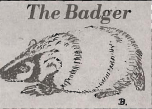The Old Badger
The Badger contacts aviators
First published in The Freeman’s Journal August 2, 1978
 “They tell us at the drugstore that since the aviators came here, the business done in lip rouge, ordinary rouge, and other forms of calsomine has almost doubled. And Schneider and Raubacher, who do most of the clothes cleaning say that the way the officers’ uniforms catch up talcum powder along the sleeves and shoulder is something awful.”
“They tell us at the drugstore that since the aviators came here, the business done in lip rouge, ordinary rouge, and other forms of calsomine has almost doubled. And Schneider and Raubacher, who do most of the clothes cleaning say that the way the officers’ uniforms catch up talcum powder along the sleeves and shoulder is something awful.”
— The Freeman’s Journal, July 16, 1919
The year of “the flyers” in Cooperstown was 1919. (Pete Hollis sat up and looked around that year, too. Maybe that had something to do with it.) Almost 500 handsome, young aviators were housed in the village that summer, some for a few weeks, others for much longer – officers and gentlemen of the Aviation Section of the U.S. Army who had been ordered to Cooperstown for rest and relaxation before being mustered out of the service after World War I.
But let’s go back to May of 1918 and this announcement in The Freeman’s Journal: “The Mary Imogene Bassett Hospital is to be the main institution in the United States for the recuperation of aviators suffering from nerve shock caused by flying at high altitudes. Men suffering from contagious diseases will not be brought to Cooperstown but will be treated at the regular Army hospitals.”
Even though the Bassett Hospital was unfinished at the time, Edward S. Clark had offered to rush one wing to completion for the care and hosting of the flyers, under government supervision, of course.
Our own Thanksgiving Hospital on Grove Street was busy enough with the local customers.
The newspaper announcement continued: “Physical Directors will be supplied who will outline a plan of rest and recuperation. Alfred Corning Clark Gymnasium, the Village Club (the present library building) and the Golf Links will be thrown open to the aviators the majority of whom will be officers, and everything possible will be done to make their stay enjoyable.”
The aviators began to trickle into the village in January of 1919 but the hospital wasn’t quite ready. Some of them were temporarily housed in the Village Club, some in the Jordan house, but by May, one hospital wing was ready to receive them. They moved in and their orderlies were billeted on Pioneer Street next to the American Hotel which had recently become the Tunnicliff Inn.
The year-old Chamber of Commerce welcomed them. Bill Smalley, with his infant movie business, welcomed them. Len Rayner at Golf Links was pleased. So was J. Harry Cook, with his new automobile business. Mrs. F. de Puyster Townsend welcomed them, and early that winter set up a Red Cross hostess center at her home on Brookwood Point. Roaring fires, teas and cakes, and sympathetic hostesses welcomed the young heroes. But not for long. The April papers tell us that the Red Cross hostess center was peremptorily closed and moved from “Brookwood” to “Glimmerglen,” apparently the first of many social rumbles in town.
Subsequently Mrs. Townsend’s “boys” published a poem of gratitude and appreciation for her hospitality, but henceforth the official activities took place at Hyde’s – and the unofficial activities took place at The Otesaga and the golf links and the tennis courts – and in boats and cars, or at the dance halls, or in the woods or in the houses of our residents.
But who were our residents? … Our residents were typical of any small resort in that day – laborers, farmers, merchants, brokers, a few professional men and here and there a millionaire, all jostling for positions of advantage in whatever pack they were running with, all “getting on with it” in the unusual untidy fashion.
Cooperstown had sent 200 young men and women to the war. But now the war was over and 170 would return. The German scare was over. (The Busch property was no longer threatened by the Alien Property Custodian. The wireless hidden in the chimney at River and Main was no longer an issue.) Food and fuel shortages were over, too. Main Street was being paved. People were starting to install telephones. The last livery stable in town had closed, and automobiles were “the rage.” The “movies” had appeared, and the dance orchestras were playing – “For Me and My Gal,” “There’s a Long, Long Trail a’Winding,” “I Don’t Want to Get Well, I Don’t Want to Get Well, I’m in Love with a Beautiful Nurse.”
When an aeroplane flew over town, it rated a headline in the paper, and then, along came 500 dashing young aviators with pay in their pockets and nothing to do but have a good time.

